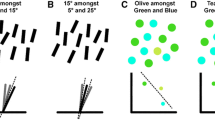Abstract
It is known that visual direction representation is more accurate for cardinal directions compared to oblique, a phenomenon named the “oblique effect”. It has been hypothesized that there are two sources of oblique effect, a low level one confined to vision and a high level one extending to different modalities and corresponding to higher cognitive processes. In this study directional error (DE) was measured when normal individuals tried to align the direction of an arrow presented in the center of a computer monitor to the direction of a peripheral target located in one of 32 directions equally spaced on an imaginary circle of 60 mm radius. Task difficulty was manipulated by varying arrow length (15, 30, 45 and 60 mm). By measuring mean DE and its variance we identified two independent sources of the oblique effect. A low level oblique effect was manifested in higher accuracy or equivalently lower variance of DE in the alignment for cardinal orientations compared to oblique. A second oblique effect was manifested measuring mean DE resulting in space expansion in the vicinity of cardinal directions and space contraction in the vicinity of oblique directions. Only this latter source of oblique effect was modulated by arrow length as predicted from a theoretical model postulating that this oblique effect is produced by a cognitive process of 2-D space categorization.




Similar content being viewed by others
References
Appelle S (1972) Perception and discrimination as a function of stimulus orientation: the “oblique effect” in man and animals. Psychol Bull 78:266–278. doi:10.1037/h0033117
Baud-Bovy G, Gentaz E (2012) The perception and representation of orientations: a study in the haptic modality. Acta Psychol 141:24–30. doi:10.1016/j.actpsy.2012.06.002
Baud-Bovy G, Viviani P (2004) Amplitude and direction errors in kinesthetic pointing. Exp Brain Res 157:197–214
de Graaf JB, Sittig AC, van der Gon JJD (1991) Misdirections in slow goal-directed arm movements and pointer-setting tasks. Exp Brain Res 84:434–438
de Graaf JB, Sittig AC, van der Gon JJD (1994) Misdirections in slow, goal-directed arm movements are not primarily visually based. Exp Brain Res 99:464–472
Essock EA (1980) The oblique effect of stimulus identification considered with respect to two classes of oblique effects. Perception 9:37–46
Essock EA, Krebs WK, Prather JR (1992) An anisotropy of human tactile sensitivity and its relation to the visual oblique effect. Exp Brain Res 91:520–524
Essock EA, Krebs WK, Prather JR (1997) Superior sensitivity for tactile stimuli oriented proximally-distally on the finger: implications for mixed class 1 and class 2 anisotropies. J Exp Psychol Hum Percept Perform 23:515–527
Freeman J, Brouwer GJ, Heeger DJ, Merriam EP (2011) Orientation decoding depends on maps, not columns. J Neurosci 31:4792–4804
Furmanski CS, Engel SA (2000) An oblique effect in human primary visual cortex. Nat Neurosci 3:535–536. doi:10.1038/75702
Gentaz E, Baud-Bovy G, Luyat M (2008) The haptic perception of spatial orientations. Exp Brain Res 187:331–348. doi:10.1007/s00221-008-1382-0
Gourtzelidis P, Smyrnis N, Evdokimidis I, Balogh A (2001) Systematic errors of planar arm movements provide evidence for space categorization effects and interaction of multiple frames of reference. Exp Brain Res 139:59–69
Huttenlocher J, Hedges LV, Duncan S (1991) Categories and particulars: prototype effects in estimating spatial location. Psychol Rev 98:352–376
Huttenlocher J, Hedges LV, Corrigan B, Crawford LE (2004) Spatial categories and the estimation of location. Cognition 93:75–97. doi:10.1016/j.cognition.2003.10.006
Krukowski AE, Stone LS (2005) Expansion of direction space around the cardinal axes revealed by smooth pursuit eye movements. Neuron 45:315–323
Maffei L, Campbell FW (1970) Neurophysiological localization of the vertical and horizontal visual coordinates in man. Science 167:386–387
Mantas A, Evdokimidis I, Smyrnis N (2008) Perception action interaction: the oblique effect in the evolving trajectory of arm pointing movements. Exp Brain Res 184:605–616. doi:10.1007/s00221-007-1255-y
Serences JT, Saproo S, Scolari M, Ho T, Muftuler LT (2009) Estimating the influence of attention on population codes in human visual cortex using voxel-based tuning functions. Neuroimage 44:223–231
Smyrnis N, Gourtzelidis P, Evdokimidis I (2000) A systematic directional error in 2-D arm movements increases with increasing delay between visual target presentation and movement execution. Exp Brain Res 131:111–120
Smyrnis N, Mantas A, Evdokimidis I (2007) “Motor oblique effect”: perceptual direction discrimination and pointing to memorized visual targets share the same preference for cardinal orientations. J Neurophysiol 97:1068–1077
Swisher JD, Gatenby JC, Gore JC, Wolfe BA, Moon CH, Kim SG, Tong F (2010) Multiscale pattern analysis of orientation-selective activity in the primary visual cortex. J Neurosci 30:325–330
Acknowledgments
This work was partly supported by the “Kapodistrias 2004-2005” program of research support from the National and Kapodistrian University of Athens.
Author information
Authors and Affiliations
Corresponding author
Rights and permissions
About this article
Cite this article
Smyrnis, N., Mantas, A. & Evdokimidis, I. Two independent sources of anisotropy in the visual representation of direction in 2-D space. Exp Brain Res 232, 2317–2324 (2014). https://doi.org/10.1007/s00221-014-3928-7
Received:
Accepted:
Published:
Issue Date:
DOI: https://doi.org/10.1007/s00221-014-3928-7




